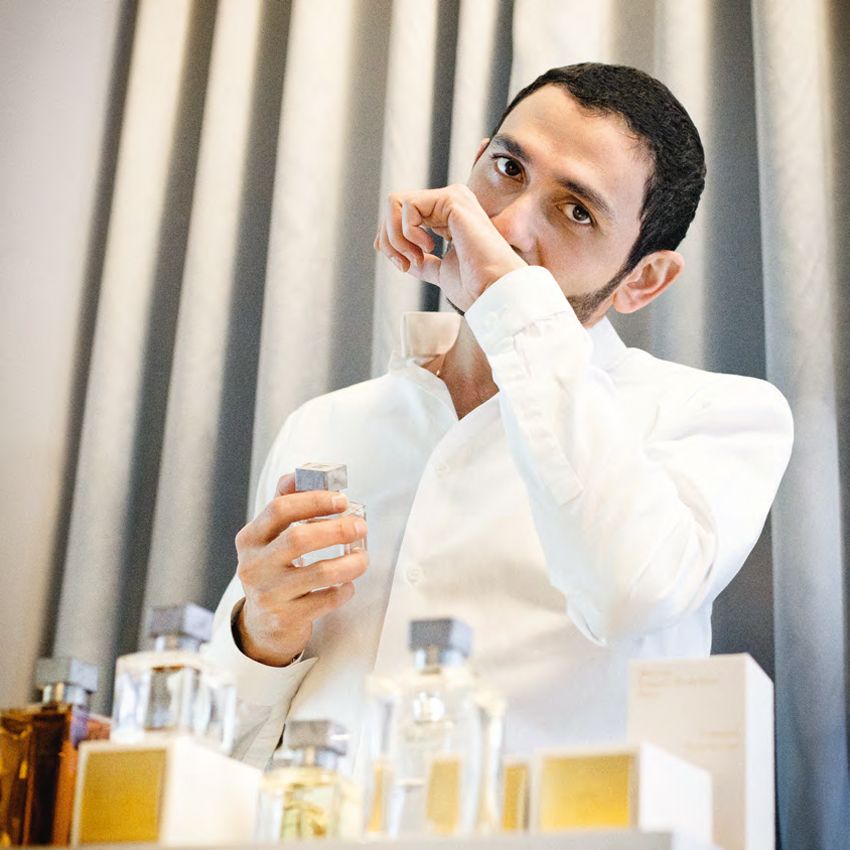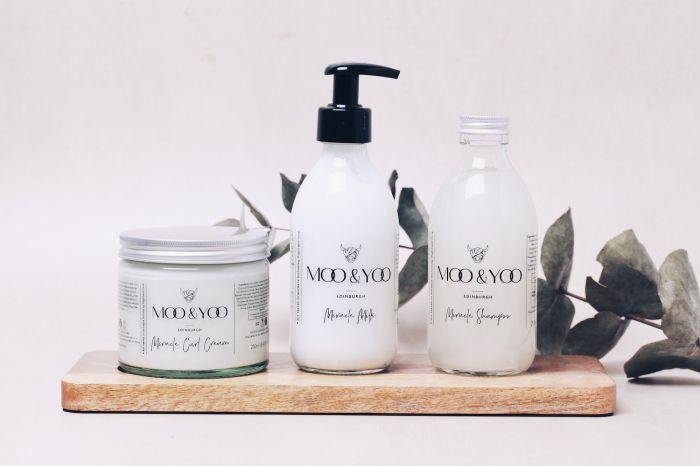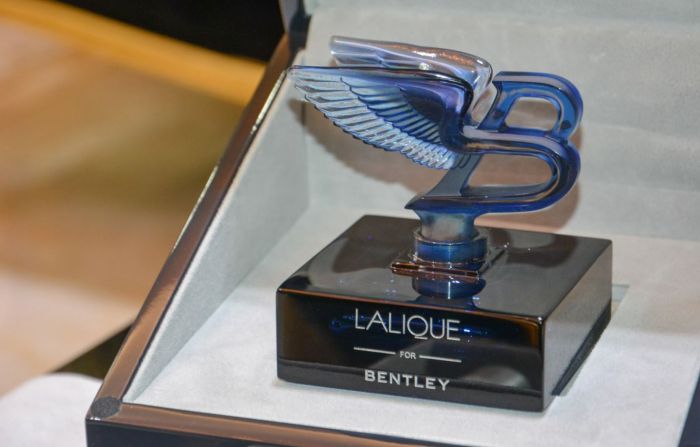
If I were to ask who designed your recently-acquired Louis Vuitton Dora bag, you might be able to casually toss out the name Nicolas Ghesquière. Fashion-forward women know Alexander Wang is backing Balenciaga, Riccardo Tisci is designing for Givenchy and Raf Simons is in charge of the collections at Dior, but can you name the designer behind the fragrances sitting on your vanity? We spoke with the man behind some of your favorite fragrances at Dior, Acqua di Parma and Guerlain—Francis Kurkdjian. A master perfumer, Kurkdjian has had his own atelier since 2001, a place where socialites, celebrities and the well-heeled flock for his custom-made fragrances. His eponymous label reflects his own creativity at work and houses a collection of over 20 different fragrances for men and women. Some of our favorites include the unisex Aqua Universalis and APOM femme, strong scents that showcase Kurkdjian’s talent, creativity and passion for fragrance.

JustLuxe: You are now one of the most sought after perfumers in the world, but can you talk a little bit about your background and what lead you into perfume?
Francis Kurkdjian: There was not even the shadow of a perfumer on the horizon in my family. After a short-lived career as a classical ballet dancer, I pursued couture to continue my family history: the father of my mother was a tailor, and the father of my father was a wedding dress designer. Both had their own ateliers with a private clientele in Paris. Unfortunately, my pencil refused attempts at design, and I could not enter the design/fashion school I wanted.
At age 14 I read an article about several perfumers in the glossy pages of a French magazine. It was a true revelation. There were real people behind the creation of perfumes and it was a very special craft. Perfume was so much linked to the couture world that it became obvious to me I would become a perfumer. After reading that piece, I then decided I would become a perfumer myself and embraced this path as a career. I started to do some research about perfume schools in France and abroad. I wrote letters to different luxury and fragrance companies to get more information about the métier. Finally an executive at Lancôme wrote me back and told me about ISIPCA, the perfumer school based in Versailles, France. At age 15, I convinced my parents to take me there in order to visit the school. We had a meeting with the director who told me I was too young of course, and had to come back after [I obtained] a master degree in science. Five years later, I applied ISIPCA at age 20 and graduated in 1992.

JL: What made you want to branch off on your own and start your own line?
FK: The creation of my own brand was a natural process, like something I had to do: create and then share with the public. The world of Maison Francis Kurkdjian expresses what I believe in the terms of luxury and fragrances. My house is a tribute to Paris and each scent is part of fragrance wardrobe to accompany each of us, every day, day after day and every night. Maison Francis Kurkdjian is the house of a perfumer and nests the true art of perfume making.
JL: Many of your fragrances are made for both men and women; why do you create so many unisex fragrances and what makes them unique?
FK: Not all the creations of Maison Francis Kurkdjian are unisex/genderless. Four of them have been specially created to work as a couple (available for him and her separately): APOM, Lumière Noire, Amyris and Pluriel. Ingredients and raw materials in perfumes are like colors for fashion. You can use all of them to create a man’s or woman’s perfume; it’s a question of balance and aesthetics. It’s also a question of culture.

JL: Where do you draw inspiration for your collection?
FK: Inspiration is the invisible part of creation. Although it takes a team effort to manufacture and launch a product, the first creative steps are rather lonely. So when I create a single fragrance that won't be on the market, my part remains the same.
My inspirations are not driven by raw materials. I first focus on a general feeling. Then I try to envision the final image for the fragrance. I dream my fragrance, only then do I start writing the formula. How do you create something if you don’t know what you want to say? A painter uses colors, a musician, notes, as a perfumer I use smell. The name of the fragrance always comes first. It sums up what I want to say with my perfume. It’s like the title of a book or the name of a painting. It gives me a guideline, a creative path to follow.
Behind each Maison Francis Kurkdjian fragrance I have created, there is a story and my creative process gathers inspiration from many different fields: Absolue pour le Matin is about light and sun, sleeping in late, cotton and linen, a pillow. A story I have created from the first pages of Bonjour Tristesse, a novel by French writer Françoise Sagan…Absolue pour le Soir is a total different story. It’s about all about sex, drugs and leather; a very '70s fragrance inspired from Studio 54 in New York City. APOM is an acronym that stands for A Part Of Me; it was inspired from my trips to Lebanon almost 10 years ago. Lumière Noire was created as a tribute to French actress Catherine Deneuve, for whom I have created a bespoke scent as well. Lumière Noire is to me the pure French style in perfume, based on an accord of rose and patchouli.
Amyris pour femme and pour homme (launched last year), reflects the effortless elegance of Parisian women and men. The Oud mood collection reflects my sources of inspiration, and some ideas I found during [my time alone] with the raw material while creating Oud. I have imagined them as sensations, feelings, textures and fabrics. They play on warmth, glamour, comfort and sensuality. Their preciousness, intensity and concentration make them stand out.

FK (cont'd): Oud velvet mood is enveloping as velvet and gives the sensation of density and fluidity. Main notes are cinnamon from Ceylan, saffron and Brazilian copahu balm.
Oud silk mood is a silky fragrance, a light and airy fragrance reminiscent of the soft touch of a petal. It combined Bulgarian rose with blue chamomile from Morocco and papyrus. Oud Cashmere mood is an oriental fragrance, woven with all the gentleness of a “second skin”. It’s soft and balmy, and Oud is enhanced with Moroccan labdanum, Laotian benzoin and vanilla.
For Pluriel, I came with the idea we (woman or man), as individual, having multiple lives not only in one day but during the course of our lifetime as well. We are multiples as we experience so many different things together; beings connected to a global world. Nevertheless, we remain one single person, one individual. This is how and why I came up with Pluriel (Plural).
Then I asked myself what would be the associated scent with such a name. I decided to explore the idea of a timeless fragrance that will gather all the facets of our personality. However, I rapidly could not envision one single scent carrying all my emotions. Women and men are so different. Hence, I decided to add the French adjectives féminin (for feminine) and masculine (for masculine) before each scent.
Both fragrances are inspired with the same idea of timeless elegance. During their creation, I was obsessed with the quest of what makes a fragrance timeless, what are the elements that convey the idea of passing through time. In my mind, each scent on its own had to be the essence of femininity and masculinity with no doubt, no question. That was my creative challenge.

JL: Since the olfactory sense is one of the strongest tied to memory, do you think about how your creations can become part of someone’s memory and life experiences when you begin a fragrance?
FK: The olfactive memory is the most ancient memory we have as human beings. It is very primal. Each of us has different reactions to scents. It is undeniable that there are emotional and psychological effects attached to each of them. Perfume is an art, a silent art that makes your memory talk.
JL: Before starting your own brand you created scents for some of the biggest names in fashion and continue to do so with the latest release of Burberry’s My Burberry fragrance. Can you explain the process for a fragrance collaboration? Which brands have been your favorites to work with?
FK: I have been working for luxury and high-end beauty brands for the past twenty years. To name a few: Dior, Lancôme, Guerlain, Elie Saab, Lanvin, Armani, Van Cleef & Arpels, Jean Paul Gaultier, Yves Saint Laurent, Versace, Ferragamo, etc… I love creating olfactory installations and working with other artists; it is always a great experience. It opens your mind and views on aesthetics, you share ideas and from that there is always something amazing that comes out.

JL: What steps do you go through to create a fragrance—from inspiration to bottle?
FK: The heart of my inspiration is Paris and each Maison Francis Kurkdjian fragrance is part of a fragrance wardrobe that I build year after year. My travels take me away, but they also serve to bring me back to my Paris, and its heterogeneous population, to the light and the shade of its monuments, the gray of its rooftops and the bursts of magic as its golden spires puncture here and there in its incredible skyline. Paris inspires the universal [colors of] my house: gray zinc and gold. The inspiration for the flacon comes from an antique bottle. To underline it, I added a small signature—the monogram of the House—at the back of the flacon, much in the manner of artists signing works with pride. A tube extends from the atomizer pump, but seems to disappear after the first spray, leaving the perfume languid in its container. We wanted a stopper made of a material emblematic of Paris. We choose gold and an alloy of zinc. Zinc is alive and interesting in that it refuses uniformity. Thus, no two stoppers are identical; each has its own unique variation dependent on the density of the gray color. We made the same choice for the bases of the candles. The alloy is only treated to prevent oxidation.

JL: What have been your favorite fragrances to create? What are some of your favorite notes to work with?
FK: The idea of a favorite creation for me does not exist. I look ahead and not behind. I have learned how to hate your past creation in order to be able to envision the new ones. My favorite ingredients are the ones that help me to create the fragrance I have in mind!
JL: You made your first real impression on the perfume market when you were only 25 with Jean Paul Gaultier's Le Male, since then you’ve become one of the world’s most celebrated perfumers and have traveled all around the globe. What are some of the most important things you have learned from your years of practice and experience?
FK: After all these years creating fragrances I slowly understood that a solid perfume subtlety combines aesthetic and technique (This is what I teach at ISIPCA, the perfumery school based in Versailles): a new olfactory signature needs to be built on a good architecture. Volume and diffusion are very important, not to say key. They are the technical part of a fragrance. Not everyone (perfumers) has the know-how to create long lasting fragrances. It’s a real challenge but this is truly were the craft is. That technical aspect is very close to what you see in paintings. Leonardo da Vinci is famous for sfumato for example, so it goes beyond the subject of the painting.

JL: What do you think of the fragrance industry today? Is there anything you observe that needs to be focused on or changed?
FK: The perfume industry is at a turning point like other industries such as music, cinema, etc… But overall, my feeling is that the métier has never been so exciting. The creative playground has expanded so dramatically over the past 20 years, opportunities are ahead! Few points need nevertheless, to be addressed: People might think perfumers are artists and yet, the industry does not treat them that way! If we think about fashion designers, designers, musicians, photographers, many issues need to be addressed. I also believe there is a risk of scarcity of talented perfumers. It takes time to train young perfumers and the economic constrains of the major companies are not really compatible with the time needed to train the younger generation. Part of my time is dedicated to education either at ISIPCA, or internally within Takasago in Paris. I do believe it is key to transmit the craft to younger ones in order to maintain the transmission of the craft. And you learn so much yourself by teaching!
Another challenge for perfumers is lasting as a creative force in an industry that launches so many perfumes which [do not last long] on the shelf. You have to be able to combine fragrances that sell well with creativity and audacity, which is not the easiest thing to do, and not every brief or brand can allow that. I have seen perfumers being sacked because they were not in a profitable cycle for few years. Who would have thought that 20 years ago! Another point concerns "premium" brands which now clearly favor the “in-house” perfumer whose creative talent is the strength of proposals in the same way designers are for fashion brands. Little by little, the perfumer continues its way to the front of the stage.














